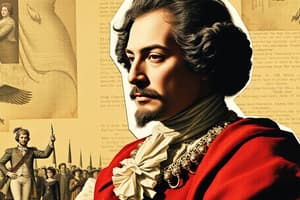Podcast
Questions and Answers
What significant financial challenges did France face under Louis XVI?
What significant financial challenges did France face under Louis XVI?
- Reduced court expenses
- Increased profits from agriculture
- High interest rates on loans (correct)
- Surplus from American trade
What was the main composition of the Third Estate?
What was the main composition of the Third Estate?
- Only nobility and clergy
- Only small landowners and laborers
- Rich businessmen and poor peasants (correct)
- Merchants and landowners exclusively
Which group among the estates was responsible for paying all taxes?
Which group among the estates was responsible for paying all taxes?
- Nobility
- Clergy
- Third Estate (correct)
- Royal family
What tax was levied by the Church on agricultural produce?
What tax was levied by the Church on agricultural produce?
Which statement about land ownership in France during this period is accurate?
Which statement about land ownership in France during this period is accurate?
Flashcards are hidden until you start studying
Study Notes
Louis XVI's France
- Louis XVI became King of France in 1774 at the age of 20.
- He married Marie Antoinette.
- France's financial situation was dire due to years of war and excessive court spending.
- France further burdened itself by supporting the American colonies during their fight for independence.
- High interest rates on loans exacerbated the financial situation, forcing the government to allocate a significant portion of its budget to interest payments.
French Society and Estates
- French society was divided into three estates: the clergy, nobility, and the Third Estate.
- The clergy and nobility enjoyed tax exemptions.
- The Third Estate was comprised of various groups, including wealthy businessmen, merchants, and lawyers, as well as peasants and artisans.
- Peasants, who made up around 90% of the population, were further divided into land-owning peasants (approximately 60%) and landless laborers and servants.
- The nobility, clergy, and wealthy members of the Third Estate owned most of the land.
Peasant Burden
- Peasants bore the brunt of the tax burden.
- They were responsible for the taille (direct tax) and various other indirect taxes.
- The clergy collected tithes (taxes on agricultural produce).
- Nobles imposed feudal dues, obligating peasants to work for them, serve in the army, or contribute to road construction.
- The Third Estate, despite being responsible for all taxes, had no representation in the government.
Studying That Suits You
Use AI to generate personalized quizzes and flashcards to suit your learning preferences.




